Bali is the island of a thousand gods. And since there are so many gods, there should be plenty of temples as well.
According to official data, there are around 20,000 temples in Bali, including state, municipal, clan, and private temples. The most significant temples are located in special places—stunningly beautiful, sometimes dangerous, and ritually significant.
When visiting a temple, don't forget to wear a sarong and a sash. This way, the locals will welcome you warmly and share their traditions with you.
Pura Besakih
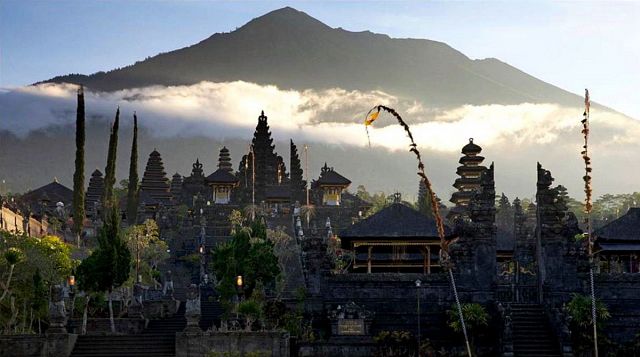
What's interesting: The most important temple complex on the island is also known as the "Mother of all Temples," Besakih. It's the sacred center and foundation of the Hindu religion. The Besakih Temple consists of 23 individual temples on six levels covering an area of almost three kilometers. Some of the structures date back to the 10th century.
In 1963, during the eruption of Mount Agung, lava stopped just a few meters away from Besakih, sparing the temple. The locals considered this a miraculous intervention by the gods, and since then, the temple is even more revered. Besakih is part of the list of six sacred temples (Sad Kahyangan) and nine directional temples (Kahyangan Padma Bhuwana), of which it is the central one.
Location: The Besakih Temple complex is located in the Karangasem regency, 63 kilometers northeast of Denpasar, on the southwest slope of Mount Agung. You can get there independently or as part of a tourist group by bus. All Balinese tourist agencies organize excursions to the temple.
Parking is situated about a kilometer away from the central entrance of Pura Besakih, which means you'll need to walk that distance. If you're driving independently, note that tickets are sold at the entrance to the territory, near the parking area.
Best time to visit: It's recommended to plan your visit to Besakih in the early morning. By noon, tour groups gather at the temple complex, and it becomes quite crowded. This is especially true if there's a large ceremony taking place. After lunch, there's a high chance of fog, as the pagodas are situated at an altitude of over 1000 meters above sea level.
Small ceremonies in the temple complex of Besakih occur several times a day. Foreigners are allowed to observe and take photographs, but entering the altar area during sacred rituals is strictly not recommended. To enter beyond the fence, wearing a sarong is mandatory. You can rent or buy sarongs at souvenir shops near the temple. Rental costs around 25,000 Indonesian rupiahs, and buying one is around 50,000 Indonesian rupiahs.
Entrance fee: Rp. 60,000 per person / Rp. 5,000 per vehicle.
Opening hours: 08:00 AM - 05:00 PM.
Pura Taman Ayun
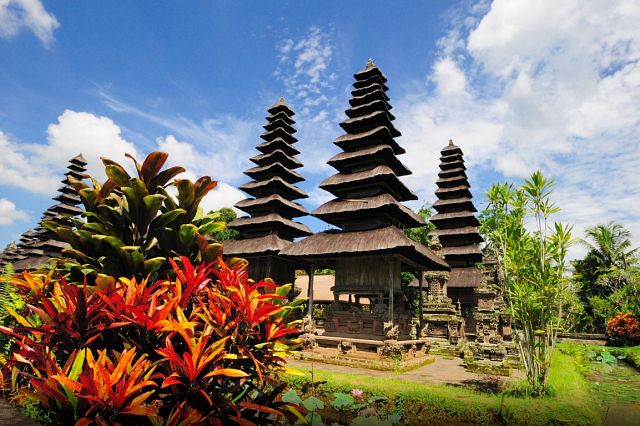
What's interesting: Pura Taman Ayun is the second largest temple complex in Bali after Besakih, a place of exquisite beauty and atmosphere. It was built as the royal temple of the Mengwi dynasty. Until 1891, Pura Taman Ayun was considered the main temple in the entire kingdom. There are 11 pagodas on the premises symbolizing the sacred Mount Mahameru. It is believed that this mountain represents the axis of our entire world and is situated at the center of the Universe. At its summit resides the Supreme Deity, as well as the souls of the departed.
The name translates to "Temple in the Garden," and the temple complex still features a beautiful garden: intricate towers, pavilions, a theater, fountains, and an abundance of flowers. The inner temple is surrounded on all sides by ponds with blooming lotus flowers and fish.
Location: Pura Taman Ayun is located in the south of the island, not far from the village of Mengwi.
Admission fee: Rp. 20,000 for adults / Rp. 7,500 for children
Opening hours: 08:00 AM — 06:00 PM
Gunung Kawi
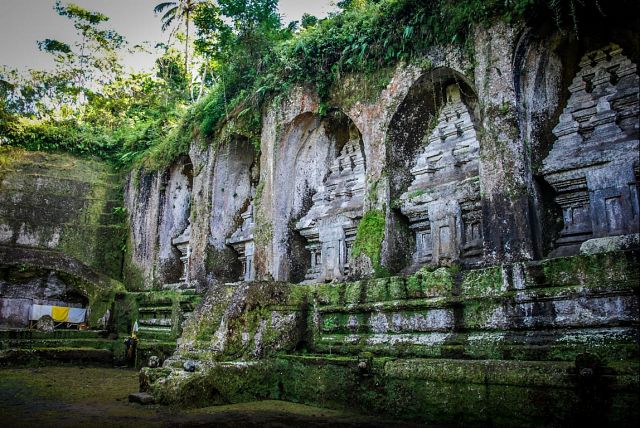
What's interesting: The ancient cave complex of Gunung Kawi is famous for its royal tombs carved directly into the rocks. The site features 10 gigantic statues depicting the royal family of the Udayana dynasty. If you cross the bridge at the bottom of the valley, you can reach another temple carved into the rock.
Around the complex, there are many jungle paths for walks, rice terraces, nearby famous springs, a waterfall, a mountain river, and an impressive trail along the edge of a steep cliff. Many people note that the atmosphere in this place is so peaceful that you'd want to stay here longer.
Location: Situated in the Pakrisan River valley near the village of Tampaksiring, approximately 25 km north of Ubud. The path leading to the temple passes through picturesque rice terraces. Gunung Kawi is practically in a ravine, by the river. To reach it, you need to descend 371 steps.
Best time to visit is early morning.
Entrance fee: Rp. 15,000 for adults / Rp. 5,000 for children
Opening hours: 07:00 AM — 05:00 PM
Pura Ulun Danu Bratan
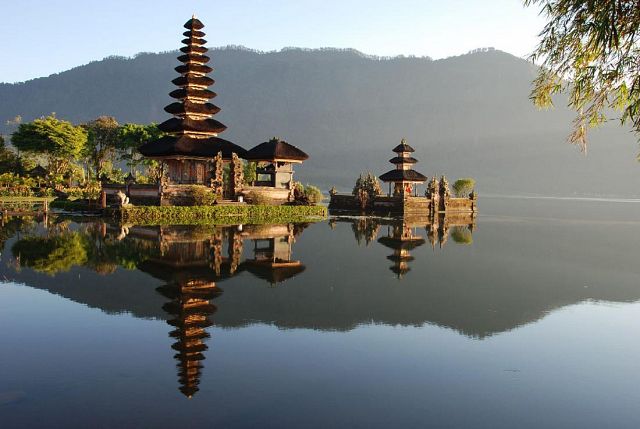
What's interesting: This is perhaps the second most photographed temple in Bali. Pura Ulun Danu Bratan is one of the nine spiritual centers of the island. The main temple is dedicated to the water goddess Dewi Danu. Ceremonies are very often held here. According to ancient tradition, anyone who bathes in the lake, thus undergoing a purification process, will be granted youth and longevity. This is why Balinese people come to the lake to bathe in the consecrated water at least once a year.
Where it's located: On the shores of Lake Bratan, in the Bedugul area.
The most unforgettable impression will be if you witness the sunrise here: the sunlight passing through the morning mist brightly illuminates the water and the temple itself. Even better, rent a boat and experience the sunrise on the lake with a view of the temple and the mountains.
Entrance fee: Rp. 60,000 for adults / Rp. 10,000 for children
Opening hours: 07:00 AM — 05:00 PM
Pura Tirta Empul
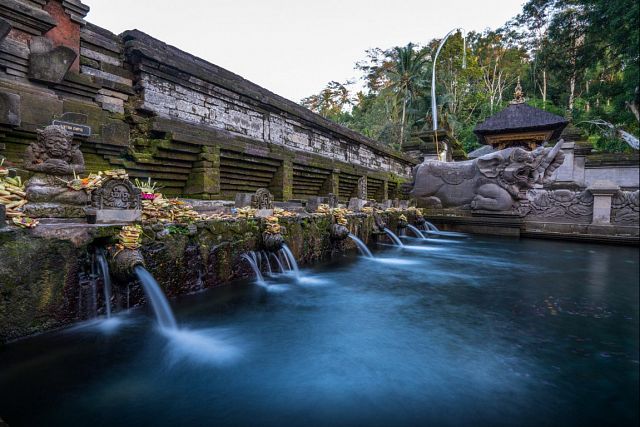
What's interesting: Pura Tirta Empul is an ancient Hindu temple of holy water (built in 926 AD) and sacred springs. It features three long rectangular pools surrounded by intricate stone reliefs. These pools are filled by 12 fountains, and the water is considered sacred and believed to possess healing properties.
After the temple service and offerings, worshippers always proceed to bathe and pray in the main pool. They start from the first pool, pass through the fountains with the sources, offering prayers at each, mentally expressing their requests, and dunking their heads under the water source three times. They then move on to the next pool, where the same ritual is performed. At the end of the cleansing process, they need to drink eleven sips of water.
Where it's located: Tirta Empul is situated near the town of Tampaksiring, about 39 km east of Denpasar. From Ubud, it takes around 30 minutes to drive north towards the Kintamani area and the large caldera.
Entrance fee: Rp. 15,000 for adults / Rp. 5,000 for children
Opening hours: 08:00 AM — 06:00 PM
Pura Luhur Lempuyang
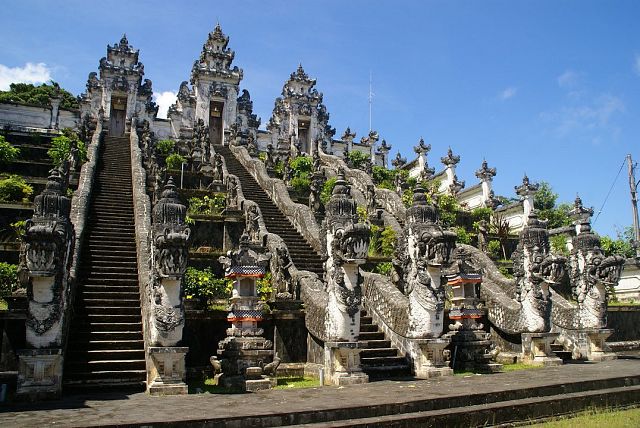
What's interesting: Pura Luhur Lempuyang is one of the most sacred temples on the island. It's often referred to as the "Stairway to Heaven" or the "Road to the Clouds" due to its incredibly magical setting. To reach the main temple, you'll need to climb 1,700 steps along the staircase, a journey that takes about 3 hours and is considered a short route. Alternatively, you can take the "long way," adding an extra loop through the jungle and passing by three other interesting temples. This path can take 5-6 hours depending on your speed.
From here, you'll have a stunning view of the volcano and the ocean. The temple is best visited during ceremonies when worshippers don their finest attire and perform beautiful rituals. However, any time you visit Luhur Lempuyang, you won't be disappointed. Priests are always present in the temples, and you can receive blessings from each of them and, if desired, discuss religion and rituals. On your way to the uppermost temple, you'll walk through mangrove and bamboo groves, and even rain and mist won't spoil the beauty.
Where it's located: This impressive temple is located a 30-minute drive from Amed in the northeast of Bali. You can reach the lower temple via the highway from Amlapura, heading towards Amed. After passing the Tirta Gangga water palace, you'll find a sign for Pura Luhur Lempuyang at one of the next right turns. Follow the signs and stay on the main road. The road will turn into a steep uphill mountain serpentine – that's your path!
Entrance fee: Donation
Opening hours: 08:00 AM — 05:00 PM
Pura Goa Lawah
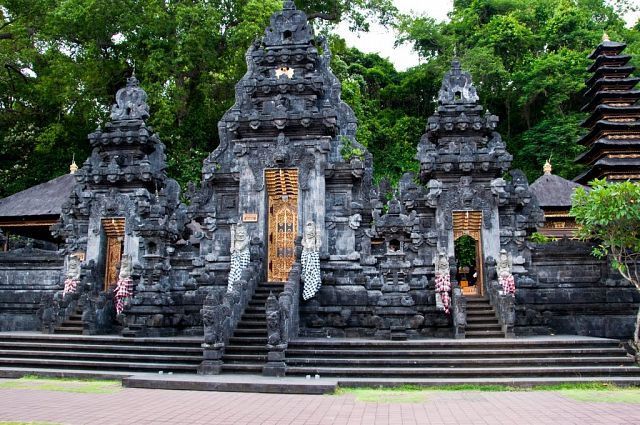
What's interesting: Goa Lawah Temple, which translates to "Bat Cave," is one of the nine major temples in Bali. The main attraction of the temple is its natural cave with a complex shape on the northern side of the temple. This cave extends about 19 kilometers deep into the mountain and is home to ten thousand fruit bats. At sunset, a unique spectacle occurs as this crowd of bats with screeches and flapping wings emerges from the cave into the sky. The sight is quite unique, sometimes eerie, and guides warn visitors about it.
Legend has it that the cave is also home to the dragon Basuki, the earthly embodiment of the god Vishnu. More precisely, it's his head that resides here, while the tail rests in Besakih. Between these temples exists a thirty-kilometer network of branching tunnels where Vishnu rests. Perhaps due to this, the Indonesian government regularly provides financial support to this temple, resulting in rich stone carvings and sculptures adorned with gold.
Where it's located: In the eastern part of the island, about one and a half hours' drive from Denpasar. The cave's exact location is in the Dawa area, Pasunggahan village.
Entrance fee: Rp. 10,000 for adults / Rp. 5,000 for children
Opening hours: 08:00 AM — 06:00 PM
Pura Tanah Lot
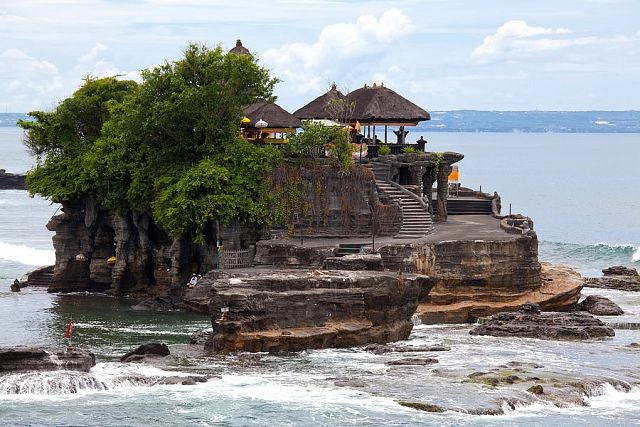
What's interesting: Tanah Lot is the most famous temple in Bali, a subject of millions of photoshoots and a cultural symbol of Indonesia. Its uniqueness lies in its location: the temple is connected to the mainland by a narrow causeway that can only be traversed during low tide. Only devout people are allowed to climb the staircase carved into the cliff and enter the temple. Tourists are restricted to the lower part of the rock. According to legend, poisonous sea snakes live in the rocky base of the temple, guarding it from evil spirits and unwanted guests.
Right by the temple, there's an official and amusingly audacious tourist swindling routine. Local workers stand before the staircase leading to the temple, denying tourists entry and explaining that to enter, they need to undergo a purification ritual. After a simple ritual, the excited tourist ascends a mere 5 steps, only to find another worker and a sign stating that further passage is forbidden. So, remember: access to the temple is exclusively for Balinese people.
When to go: This place is incredibly scenic and suitable for both daytime and evening visits, offering a beautiful sunset view. Regardless of when you visit, be prepared for a million other tourists. Additionally, during sunset, you can witness the traditional Balinese Kecak dance here.
Entrance fee: Rp. 60,000 for adults / Rp. 15,000 for children / Rp. 5,000 for parking
Opening hours: 07:00 AM — 07:00 PM
Goa Gajah
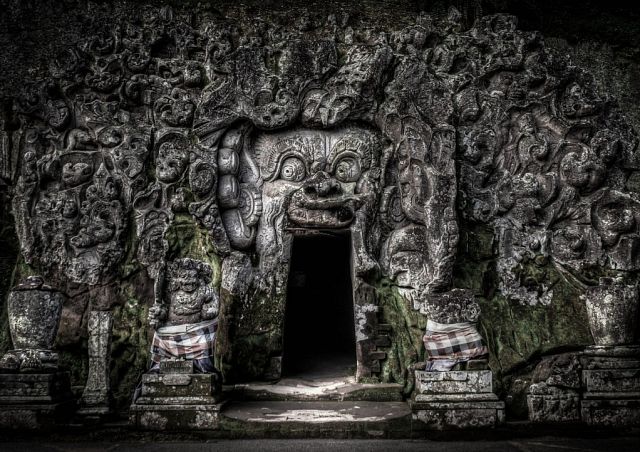
What's interesting: Goa Gajah Temple, also known as the Elephant Cave, was built in the 11th century. There are numerous elaborate legends surrounding its origin, such as the story that a giant carved the cave with his finger. Goa Gajah is an important site of Hindu archaeological excavations and was added to UNESCO's World Heritage tentative list in 1995.
Despite its name, there are no elephants here and there never were. The name comes from the statue of the god with an elephant head, Ganesha, who grants wishes and removes obstacles on the path to goals. Above the cave's entrance, a demon's head looms, symbolizing the devouring of people's negative thoughts. So, if something troubles you, this is the place to go. In addition to the cave, the temple area boasts various intriguing structures, so take your time to explore before leaving.
Where it's located: About 4 km east of the center of Ubud. It's best to arrive well before sunset to avoid wandering through the jungle in the dark.
Entrance fee: Rp. 15,000 for adults / Rp. 5,000 for children
Opening hours: 08:00 AM — 06:00 PM
Pura Luhur Uluwatu
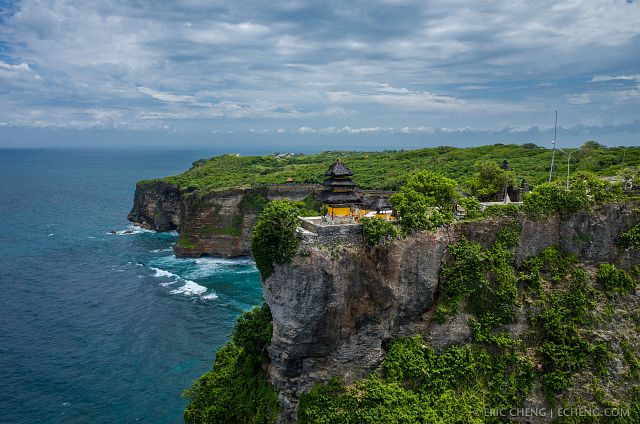
What's interesting: This is one of the most picturesque temples in Bali, located on the Bukit Peninsula. The view of the Indian Ocean from the 80-meter-high cliff where the temple is situated leaves an indelible impression even on seasoned travelers. The temple is surrounded by a forest inhabited by numerous monkeys, cared for by the temple staff. You can feed them, but be cautious: they can steal anything within their reach and might even snatch your bag.
In the evenings before sunset, you can watch a traditional Balinese performance called the Kecak dance. However, it's a good idea to secure tickets 1-2 hours before the start of the show, as tickets are often booked by groups.
Entrance fee: Rp. 30,000 for adults / Rp. 15,000 for children / Rp. 5,000 for parking
Opening hours: 07:00 AM — 07:00 PM
Hindu Temples in Different Regions of Bali
Badung
- Uluwatu Temple (Pura Luhur Uluwatu)
- Pura Geger Hindu Temple (Pura Geger) in Benoa
- Pura Taman Ayun Temple (Pura Taman Ayun)
Gianyar
- Goddess Saraswati Temple in Ubud - Pura Taman Saraswati (Pura Taman Saraswati)
- Pura Dalem Agung Padangtegal Temple in the Monkey Forest
- Batuan Temple (Pura Puseh Desa Adat Batuan)
- Gunung Kawi Sebatu Holy Springs
- Tirta Empul Temple with Holy Water (Tirta Empul)
Buleleng
- Pura Beji Sangsit Temple (Pura Beji Sangsit)
- Melanting Temple (Pura Melanting) in the north of Bali
- Pura Meduwe Karang Temple (Pura Meduwe Karang)
Karangasem
- Lempuyang Temple (Pura Lempuyang)
- Pura Besakih Temple (Pura Besakih)
Tabanan
- Pura Tanah Lot Temple (Pura Tanah Lot)
- Pura Luhur Batukau / Batukaru Temple (Pura Luhur Batukau / Batukaru)
- Ulun Danu Beratan Temple (Pura Ulun Danu Beratan) in Bedugul
Bangli
- Pura Puncak Penulisan Temple (Pura Puncak Penulisan)
- Ulun Danu Batur Temple (Ulun Danu Batur)
Klungkung
- Goa Lawah Temple with Bats (Goa Lawah)
You can add one right now!